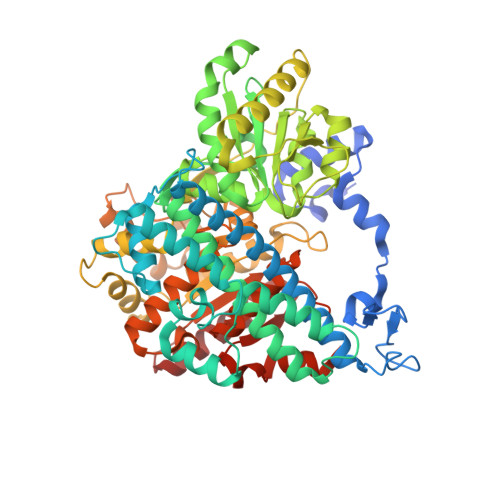N-Butyl Isocyanide Oxidation at the [Nife4S4Oh(X)] Cluster of Co Dehydrogenase.
Jeoung, J.H., Dobbek, H.(2012) J Biol Inorg Chem 17: 167
- PubMed: 21904889
- DOI: https://doi.org/10.1007/s00775-011-0839-y
- Primary Citation of Related Structures:
2YIV - PubMed Abstract:
Carbon monoxide dehydrogenases (CODHs) catalyze the reversible oxidation of carbon monoxide by reaction with water to yield carbon dioxide, two protons, and two electrons. Two principal types of CODHs can be distinguished. Ni,Fe-containing CODHs contain a [NiFe(4)S(4)OH(x)] cluster within their active site, to which the direct binding of the substrates water and carbon dioxide has been revealed by protein X-ray crystallography. n-Butyl isocyanide is a slow-turnover substrate of CODHs, whose oxidation at the active site shows several parallels to the oxidation of carbon monoxide. Here, we report the crystal structure of CODH-II from Carboxydothermus hydrogenoformans resulting from the enzymatic oxidation of n-butyl isocyanide to n-butyl isocyanate at its active site cluster. The high resolution of the structure (d(min) = 1.28 Å) revealed n-butyl isocyanate bound to the active site cluster and identified a novel type of Ni-C bond in CODHs. The structure suggests the occurrence of tetrahedral in addition to square-planar nickel complexes in product-bound states of this enzyme. Furthermore, we discovered a molecule of n-butyl isocyanide in a hydrophobic channel leading to the active site, revealing a unique architecture for the substrate channel of CODH-II compared with the bifunctional CODHs.
Organizational Affiliation:
Institut für Biologie, Strukturbiologie/Biochemie, Humboldt-Universität zu Berlin, Unter den Linden 6, 10099, Berlin, Germany.




















